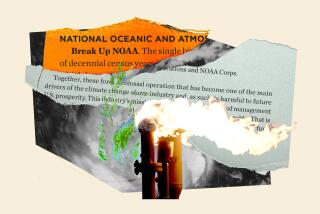White House unveils one-stop website for climate change data
WASHINGTON — As part of its campaign to address climate change, the White House on Wednesday unveiled a website to serve as a one-stop location for the enormous amount of climate data housed at different federal agencies.
The initiative to make the information easily accessible to communities, researchers and industries trying to adapt to global warming is the White House’s latest move to deliver on a pledge President Obama made in June: to use his executive authority to confront climate change in light of congressional inaction.
With climate change fueling storms, droughts and wildfires, “people are going to need to understand what is happening and what is going to happen,” said John P. Holdren, director of the White House Office of Science and Technology Policy.
NASA and the National Oceanic and Atmospheric Administration are spearheading the new Climate Data Initiative. The beta version of climate.data.gov will provide data sets on rising sea levels and coastal flooding. The site will eventually provide information about the effects of climate change on the food supply, public health and energy sources.
The initiative also will include projects launched by the private sector to provide the data about climate change through apps, cloud computing and Web tools.
The portal will “make clearer what the risks are of inaction,” said John Podesta, a senior advisor to the president and former chief of staff for President Clinton. “Localizing this information will give people a sense of how this will affect them.”
Over the last few weeks, the White House has rolled out climate change initiatives at a rapid clip.
In February, the administration created so-called climate hubs under the Agriculture Department to connect farmers and ranchers with universities, industry groups and federal agencies to help prepare for disasters worsened by climate change, such as wildfires, pests, flooding and drought.
Obama has also directed the Environmental Protection Agency and the Transportation Department to develop a new generation of tougher fuel economy standards for heavy-duty long-haul trucks.
The president also plans to ask Congress for $1 billion in his 2015 budget to establish a “climate resiliency fund” that would finance research, preparation and infrastructure to adapt to extreme weather.
In the administration’s most high-profile effort to combat climate change, the EPA in September proposed rules to cut greenhouse gas emissions from new power plants.
Obama plans to talk more frequently in the coming months about climate change, and the White House will probably unveil new efforts to cut greenhouse gas emissions through energy efficiency, said Podesta, who said he was spending about half his time at the White House working on climate change.
NOAA, NASA and other federal agencies provide detailed regular reports about long-term climate trends. NOAA routinely distributes short-term seasonal reports that focus on the outlook for extreme weather events in the U.S. But the Climate Data Initiative aims to host the information in one place where it can be used to create long-term outlooks for the potential effects of climate change, such as estimates for sea level rises that could affect coastal construction.
The cost of the project is “modest,” Holdren said, since it mostly involves connecting different agencies’ data sets. He could not provide an estimate, but he said the costs had been written into the 2015 budgets of the participating agencies.
The White House announced more than a dozen private-sector initiatives to build tools and create ways to disseminate the data. Google says it is working with the Desert Research Institute, the University of Idaho and the University of Nebraska “to provide drought mapping and monitoring for the entire continental United States in near-real time.”
Google previously created a portal called Earth Engine that uses 40 years of satellite imagery to give a time-lapse view of places around the world, such as the Amazon rain forest or the Columbia glacier in Alaska. Traffic on the site has been high, said Rebecca Moore, the site’s founder. She expects great demand for the new climate data portal as well.
“People are hungry for this kind of information, if you can give it to them in a way they understand,” Moore said. With the data available through the new initiative, it could be “possible to create a living, breathing dashboard of the planet.”
The nonprofit Climate Central, which reports on climate change, will offer a free Web tool that will provide “local projections, maps and assessments of exposure to sea level rise and coastal flooding tabulated for every coastal ZIP Code, municipality, county and state in the U.S.”
Esri, a Redlands company that specializes in geographic information systems, plans to work with a dozen cities and counties to develop ways to use climate data to address their most urgent climate preparedness concerns.
The company already has an app that estimates how many people in a given coastal area would be displaced by a 1-meter rise in sea level. In New York City, that would be 750,000 people.
The data initiative, Esri President Jack Dangermond said, “is our best shot at predicting the future.”
More to Read
Sign up for Essential California
The most important California stories and recommendations in your inbox every morning.
You may occasionally receive promotional content from the Los Angeles Times.










